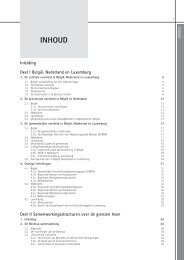The North Seas Countries' Offshore Grid Initiative - Initial ... - Benelux
The North Seas Countries' Offshore Grid Initiative - Initial ... - Benelux
The North Seas Countries' Offshore Grid Initiative - Initial ... - Benelux
You also want an ePaper? Increase the reach of your titles
YUMPU automatically turns print PDFs into web optimized ePapers that Google loves.
Specific comments relating to existing national plans<br />
In the Reference Scenario there are no new overloads in the Dutch grid that were not yet<br />
identified in the national capacity plan. <strong>The</strong> possible solutions chosen to mitigate these<br />
overloads are therefore in line with the ones proposed in the TenneT Quality and Capacity<br />
Plan 2011, except the bottlenecks for the cross-border reinforcements with Belgium.<br />
RES+ commentary<br />
In the RES+ sensitivity the installed offshore wind capacity for the Netherlands is doubled<br />
to 12000MW compared with the Reference Scenario. This capacity is again divided<br />
between the same four areas:<br />
Eemshaven 2000MW<br />
Beverwijk1 2000MW<br />
Beverwijk2 5000MW<br />
Borssele 2000MW<br />
And the existing offshore location at Velsen is also doubled to 1000 MW.<br />
<strong>The</strong> RES+ sensitivity radial design shows an offshore grid configuration that is very similar<br />
to the radial design of the Reference Scenario. Since the offshore installed wind power has<br />
been doubled, it can be seen that the number of connections to the shore has also been<br />
doubled. <strong>The</strong> windfarms connections near Beverwijk are, in this scenario, divided between<br />
four instead of two different substations to account for a more dispersed in-feed. <strong>The</strong><br />
additional interconnector from the Netherlands to Great Britain is not included in this<br />
scenario.<br />
In the RES+ sensitivity, overloads appear on the same internal Dutch lines as in the<br />
Reference Scenario, with one additional overload in the line Breukelen - Krimpen. However,<br />
the overloads in the RES+ sensitivity are significantly higher than in the Reference<br />
Scenario. <strong>The</strong> cross-border overloads between the Netherlands and Belgium have also<br />
increased in the RES+ sensitivity. <strong>The</strong>se overloads are now at such a level that the<br />
proposed reinforcements for the Reference Scenario would probably not be sufficient.<br />
<strong>The</strong>refore, when taking into account this specific scenario with extremely high crossborder<br />
flows, additional reinforcements are required. Further studies are required to<br />
determine the impact of the RES+ sensitivity in more detail and identify possible additional<br />
reinforcements. With the high wind power penetration level as assumed in the RES+<br />
sensitivity, the step towards an overlaying HVDC grid connection in the Netherlands might<br />
become an effective solution.<br />
In general the results from the different scenarios and offshore grid designs show that the<br />
offshore grid design (whether meshed or radial) does not impact the bottlenecks that<br />
occur in the Dutch onshore grid. Proposed possible grid reinforcements are therefore the<br />
same for the radial and meshed designs.<br />
Page7-53










